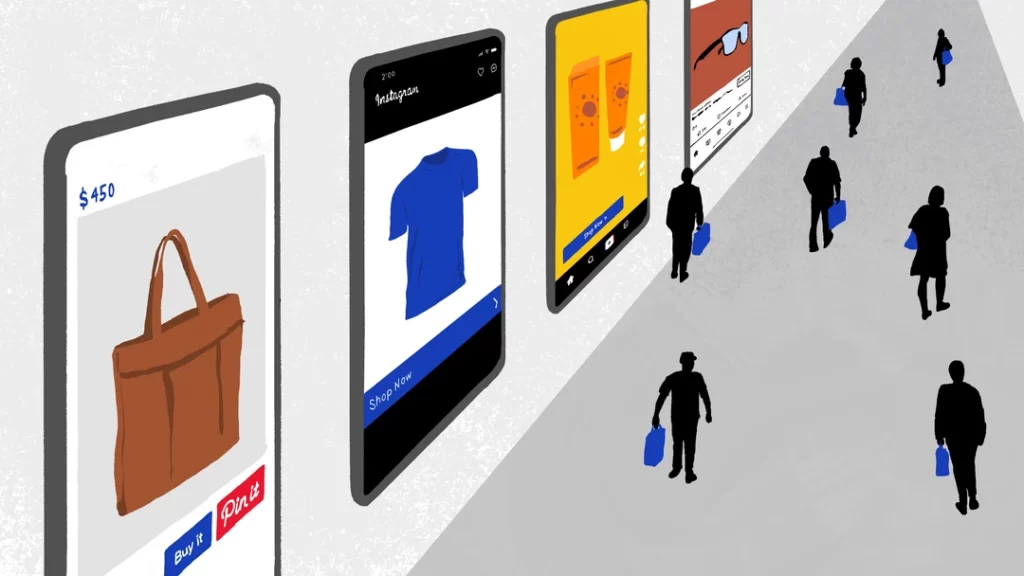Graphic Design’s Impact on Society
Graphic design. It’s something we all interact with every single day, though we may not always realise it. When you think about graphic design, you probably picture logos, billboards, magazine layouts, album covers, or other visually engaging print pieces. But graphic design is so much more than that. It’s on our phones, computer screens, TVs, product packaging – you name it. Graphic design shapes the look, feel, and functionality of the interfaces and visual elements surrounding us. It influences our purchasing decisions, how we interpret information, emotions and reactions, and beyond.
Graphic design has an expansive impact that permeates countless aspects of society. It’s a critical art form in our highly visual world. As legendary graphic designer Milton Glaser said: “There are three responses to a piece of graphic design – yes, no, and WOW! Wow is the one to aim for.” When done effectively, graphic design elicits that “wow” response that captivates viewers and conveys messages memorably. This article dives into the breadth of graphic design’s impact on society and how it changes our world through visual communication.
A Communication Game-Changer

The advent of graphic design revolutionised communication. Graphic designers unlock new dimensions of visual storytelling by using combinations of images, shapes, colours, textures, typography, and layouts. Communication is no longer reliant on text or the spoken word alone. Designers can inform, educate, persuade, entertain, and connect with audiences on profound emotional levels through visuals.
Crafting the Look & Feel of Civilisation
Graphic design aesthetically shapes the manufactured world we inhabit. Designers create the look and feel of everything from architecture to apparel to cars and aircraft. Their mark is visible across the urban realm, bringing visual harmony and order to signage systems, books and magazines, retail displays, exhibition spaces, and even entire cityscapes—graphic design principles structure how civilisations visually present themselves.
Transcending Language Barriers
Visual communication breaks down linguistic and cultural barriers in our globalised world with a universally understood language. Graphic symbols and pictograms overcome illiteracy rates and cross vernacular lines. Phone icons universally convey actions like “delete” or “settings”, while airport signage guides travellers with images, not words. Graphic design expands comprehension where language falls short.
Streamlining Complex Data
Organisations use graphic designers to visualise complex statistics, ideas, structures and hierarchies in accessible ways. Charts, diagrams, maps, infographics, and other data visualisations rapidly communicate insights that would require lengthy descriptions. Visually formatted and structured data enables quicker consumption, improving readership, shares, and citations.
- Data visualisations improve comprehension of complex concepts by 60% over text alone.
- Articles with images get 94% more views than text-only articles
- Our brains process images 60,000x faster than text
Well-designed data visualisations unite art and analytics, synthesising complex ideas into consumable graphics that advance understanding.
This principle is powerfully demonstrated in data journalism. Look, major news organisations like The New York Times and The Guardian now regularly use interactive graphics. They use them to explain complex global issues, from climate change patterns to government spending breakdowns.
Thing is, these designs transform readers. They go from passive recipients of information to active explorers of data. Users can filter, hover, and engage with the info. This makes dense topics not only understandable but also personally relevant. It’s a change that significantly elevates public discourse.
Driving Commerce & Economics

Visually striking, effective graphic design converted into complex economic returns. Forbes reports that expert use of custom graphic design in marketing materials drives 42% more revenue per visitor. Reflecting the adage “Don’t judge a book by its cover”, product packaging designs entice consumer purchases. Cereal boxes, wine labels, clothes hang tags, technology, product design, and graphics attract customers‘ attention.
Global powerhouse brands like Apple, Nike, Coca-Cola, and more weren’t built on products alone. Their logos and cohesive visual branding ignite consumer desire and identification while embodying corporate ideals. The iconic design makes stalwart reputations that drive billions in sales. Research by the Design Management Institute found that design-led companies like Apple, IBM, and Nike outperformed the S&P 500 index by 219%.
Building Credibility and Trust
Beyond aesthetics, professional graphic design is a huge part of consumer trust. Right? A polished, coherent visual identity signals that a business is professional and reliable. This is so very important in the digital realm.
Research from Stanford University has shown something telling. 75% of users judge a company's credibility purely on its website design. Without face-to-face interaction, design is a big deal for trustworthiness. A poor or inconsistent design can deter potential customers. They may see it as a sign of an untrustworthy operation. It’s the digital equivalent of a firm handshake. It is the difference between a place you'd happily give your card details to and one you'd close in a heartbeat.
The difference between Amazon and a no-name platform, or between squiggly handwriting and polished typography, is graphic design. Visually pleasing, usable interfaces drive user adoption of apps and websites. Consequently, designers hold tremendous sway over directing web traffic, conversions, and other metrics key to digital commerce.
- $1 invested in UX design yields $100 in return
- Good design increased web conversion rates by 400%
- Quality images lift conversion rates by over 63%
Overall, strategic and appealing graphic design choices compound into tremendous commercial success.
Impacting Cultural Trends & Social Change

Graphic design holds an influence far more profound than surface appearances – it continually shapes cultures. Design often reflects societal identities and the ethos of the era. Stylistic trends highlight what people value and find meaningful.
Reflecting & Directing Cultural Movements
Youth subcultures broadcast ideals using graphics-heavy mediums like posters, album art, and zines. Counterculture graphics defined the 60s psychedelia or 90s grunge aesthetic just as much as the music itself. Moving forward, street art, protest banners, and internet meme cultures demonstrate graphic design remains an outlet for activism and defiance.
Alternatively, the design also structures positive social reform. Across the non-profit sector, infographics, visual storytelling, and viral media raise awareness for causes from homelessness to human trafficking.
Policymakers have shifted laws based on the persuasive influence of visual data presentations. Purpose-driven graphic design has tremendous power to fight oppression or uplift at-risk groups.
This power is especially evident in public health. Awareness campaigns for really important issues rely on strategic design. Think smoking cessation, road safety, and mental health. The goal is to send urgent messages that resonate and change behaviour. For decades, anti-smoking campaigns used graphic, often unsettling, imagery on packaging. This starkly visualised the health consequences. Public health studies have validated this strategy for its effectiveness in deterring smokers.
More recently, initiatives like the UK's “Heads Together” campaign have used carefully selected typography. They also use approachable illustrations. This creates a safe, non-judgemental visual language. It successfully destigmatises conversations around mental wellbeing.
Normalising Social Change
Graphic communication normalises emerging cultures or marginalised groups. Gender-neutral bathroom signage visually ingrains new social conventions around gender fluidity in spaces. Sensitive graphics also counter discrimination against disabilities or ageism by depicting diversity empathetically. Business marketing integrates broader ethnic representation as societies diversify. Ultimately, graphic design parallels and reinforces societal definitions of “normal”.
Enriching Our Human Experience

Even on personal levels, graphic design enrichment permeates our human experience – often without realisation. The visual diversity delights our eyes during a simple errand, adding joy to mundane moments. Graphic design manifests the tales and ideas of our imaginations. Books filled with vibrant illustrations transport children to wondrous fictional worlds.
Playful packaging invites curiosity and discovery. Album artwork and posters magnify musical passions. Infographics ignite interest in niche curiosities and hobbies—vast industries from publishing to entertainment beckon participation through skilful visual communication. Feel-good branding adds personality to beloved products. Graphics enhance meaning, increase richness, and spark imagination in life’s little moments.
Enhancing Education and Learning
Graphic design is also a fundamental pillar of modern education. Well-designed textbooks and apps use good layout and illustration. They break down complex subjects. This makes them more digestible and improves knowledge retention. Studies show that incorporating visual aids can improve learning by up to 400%.
Educational platforms like Khan Academy and Duolingo apply these design principles well. They use clear visual hierarchies, progress bars, and illustrated characters. This helps to gamify the learning process. It keeps students of all ages motivated and makes education more accessible for many different learning styles. It’s not just for kids, mind you. The same principles help professionals get to grips with new software through clear, visual guides.
Sparking Emotions
Just as music conjures visceral emotional responses, visual artistry elicits sentiment. Iconic war propaganda motivates citizens through empathy, pride and outrage – driving societal resolve. Skilful photographers communicate heart-wrenching narratives without words that galvanise humanitarian movements. Vintage travel advertisements still ignite wanderlust across generations. Pictures cross borders and languages to open hearts. Even simple marks like emoji translate unspoken feelings. At the core, quality graphic design moves souls.
Amplifying Expression
For eccentric creators, graphic design multiplies self-expression. The possibilities are endless when conveying imaginative inner worlds through visual media. Fantasy artists build surreal universes in sublime natural landscapes just as graphic tees broadcast musical identities or personal values. Graffiti and murals turn cities into free-form canvases of creation. Online memes and gifs let personalities shine. Innovative graphic design constantly expands both individual and collective voices.
Even touching simple gift wrap transforms a mundane present into an elevated experience, visually expressing thoughtfulness. At each level, graphic design moulds environments that let people communicate freer, more fully realised versions of themselves.
Guiding Our Attention

Graphic design breaks through the noise in crowded digital spaces flooded with imagery vying for notice. Creative compositions immediately draw eyes, while scannable layouts focus concentration even as attention spans dwindle.
Streamlining Choices and Visual Hierarchy
Practical design editors must spotlight what holds meaning in chaotic flows of data. Newspaper editors curate headlines and articles worth eye. Packaging designers accentuate vital product details from fields of labels and information. TV titles illustrate which shows warrant viewership in oceans of content. Apps declutter interfaces to simplify choices.
Graphic hierarchies focus on experiences by staging visual prominence. Clean, organised graphics direct attention in consequential ways.
Rapid Visual Literacy
Inundated moderns quickly parse relevant visual information while tuning out extraneous graphics. We instantaneously comprehend critical or alert symbols without conscious thought. Even babies recognise McDonald’s golden arches or Snapchat’s ghost logo. Graphic literacy is embedded faster through visuals than words. Skilful designers tap this rapid visual processing to amplify retention and actions with strategic graphics in advertising, wayfinding, data displays and beyond.
Ultimately, graphic designers spearhead communication, commerce, social reform and human progress through creativity and understanding how images speak volumes while words fail. Graphic design empowers societies through disruptive, delightful and defiant visual feats every day.
Conclusion
Graphic design sits at the helm of visual communication and innovation. This versatile art form expands human expression beyond known frontiers. It reveals truths and inspires. Graphics give voices to visionaries and build bridges across divisions. Behind screens or on streets, graphic design surrounds citizens like the air we breathe, largely invisible in its ubiquity yet essential to contemporary life. Its influence permeates all sectors, spanning economic, social and personal realms. Though often undervalued, graphic design is one of the most potent mediums for advancing society. Creative visual communication continuously pushes progress onward and upward.
FAQs on Graphic Design's Impact
What industries most rely on graphic design?
While nearly all sectors integrate graphic design in branding, marketing, communications and beyond, some of the most design-reliant fields include:u003Cbru003EMarketing u0026amp; Advertisingu003Cbru003EPublishing u0026amp; Journalismu003Cbru003EDigital Media, UX u0026amp; UI Designu003Cbru003EArchitecture, Industrial Design, Fashion and Product Designu003Cbru003EEntertainment: Film, TV, Video Gamesu003Cbru003EArt u0026amp; Photographyu003Cbru003ENon-profit Organisations
What makes an influential graphic designer?
Great graphic designers blend creative talent with technical skills. Often, designers excel as visual communicators who understand design psychology and how to appeal to viewers strategically. They possess aesthetic flair along with mastery of required software and tools. Exceptional graphic designers also stay well-versed in cultural trends.
What graphic design skills are most in demand?
UX/UI Designu003Cbru003EAR/VR Designu003Cbru003Eu003Ca class=u0022wpil_keyword_linku0022 href=u0022https://inkbotdesign.com/services/web-design-services/u0022 target=u0022_blanku0022 rel=u0022noopeneru0022 title=u0022Web Designu0022 data-wpil-keyword-link=u0022linkedu0022u003EWeb Designu003C/au003E: Website Creation, App Designu003Cbru003EData Visualisation: Dashboards, Analytics, Infographicsu003Cbru003ESocial Media Designu003Cbru003EVideo Editing u0026amp; Motion Graphics
How do I become a graphic designer?
Most graphic designers study graphic design, visual arts, or related fields at technical schools or 4-year design programs before entering agency, in-house, or freelance roles. Some complete online certificates or intensives as well. Solid portfolios proving creative and technical competency typically outweigh degrees.
What is the future outlook for graphic design careers?
Extremely strong. The Bureau of Labor Statistics projects graphic design as one of the fastest-growing creative occupations over the next decade, estimating 10% annual job growth through 2031. Digital media expansion and continued branding and marketing investments provide plentiful opportunities. Adaptability will remain critical as designers create for emerging technologies. Those with cross-disciplinary skills will thrive most.


